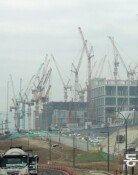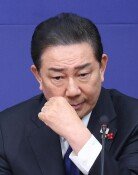HEC`s unanticipated nonviability
HEC`s unanticipated nonviability
Posted March. 27, 2001 19:08,
It is shocking to find that Hyundai Engineering and Construction (HEC)`s capital erosion is unexpectedly too much. It seems that the basic cause for the mishap is stop-gap measures provided for the ailing Hyundai Group construction arm without taking drastic or thorough steps to revitalize the firm, whenever it appealed for financial support. Whether to keep it alive or leave it moribund should be decided by such factors as the future of the nation`s construction industry, its impact on the national economy as a whole and the comparison between the value of liquidation and the value of it as a going concern. In any case, it would be too great a loss to render naught the construction company`s long accumulated knowhow and experience in the course of the construction of the atomic power plant and high-tech bridges and other up-to-date facilities for the past three decades.
In short, the HEC is the firm that represents Korea`s construction industry. HEC`s debt load has increased, mainly due to uncollected money from Iraq and the payment of interest on bank loans. Yet, the firm earned some 200 billion in profits last year. Therefore, if the company`s financial burden by means of debt-for-equity swap is reduced, the company has hope for survival. Creditor banks are said to be considering the debt-for-equity conversion, but they should not repeat the blunders that they made in the case of the bankrupt Dong Ah Construction. In the Dong Ah case, creditor banks wasted too much time before they reached a final decision on its liquidation. Notably, it is more difficult for construction firms to succeed under workout programs than manufacturing companies. This is mainly because the orders for their projects are uncertain and the range of their work is too wide. And if construction firms are deserted without strong owners, they are doomed to fail, as in the case of the ill-fated Dong Ah. What`s more, HEC is a greater and more complicated firm than the other.
To make a long story short, it is desirable for the HEC to be taken over by a viable enterprise that is well aware of the Hyundai firm and its group. The company must undertake a thorough structural reform with the born-again spirit. True, there has been criticism that many HEC executives have some personal relations with its big shareholders. Unless these kinds of shortcomings are eliminated, even debt-for-equity swaps won`t be able to enliven the nonviable enterprise. After remedial measures are taken, all big shareholders ought to wash their hands of the management of the company. It should not be permitted for public fund-injected financial institutions to leave their stake in the firm as it is, while allowing equity conversion, or to escape accountability for the managerial failures. In addition, the big shareholders incurred some losses on the company due to their undue managerial interference. They should compensate for that.
The question of nonviability involving HEC and some other Hyundai affiliates is of national concern. If the effort to revive the HEC, the nation`s representative construction arm, fails, its international credibility for other construction firms will be adversely affected and consequently they may hit a snag in receiving orders from overseas. The creditor group as well as the government needs to find out wise and efficient measures to eliminate uncertainty from the Korean economy.







